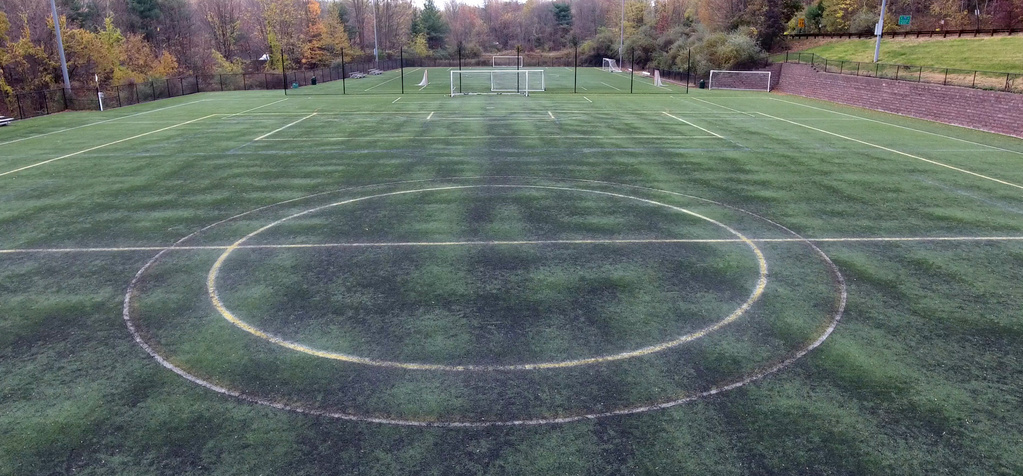Leading artificial turf company FieldTurf has been accused of making millions by knowingly selling expensive, defective fields that didn’t live up to their promises.
The allegations come from two (so far) NJ.com stories, the result of a six-month NJ Advance Media investigation by Christopher Baxter and Matthew Stanmyre. The stories also allege that FieldTurf sold these fields for years after the problems were detected, overhyped their durability and lifetime beyond what internal data showed, and then delayed replacements or refused to honor their warranties in many cases. Here’s a video they did showing what went wrong with the turf:
The issues surround the “Duraspine” turf, which FieldTurf sold from 2005 to 2012. They sold 1,428 of those fields within the U.S, at a cost of $300,000 to $500,000 per field (which could soar to over $1 million with construction and engineering costs), and earned an estimated $570 million in revenue from those U.S. fields (to say nothing of the other ones they sold globally). That money’s a big deal, as much of it came from public schools, and thus from taxpayer funds. Duraspine was a different surface than FieldTurf’s initial slit film (plastic blades cut into fibers, bunched and sewn to a carpet backing, then filled with sand and rubber), instead made from a monofilament approach pushed through an extruder, and it was promoted as the next great advance in long-lasting turf.
In 2003, then-FieldTurf CEO John Gilman (a former CFL quarterback who co-founded the company in 1995 with former tennis pro Jean Provost, who had previously been installing individual artificial turf tennis courts for rich clients) met with Jeroen van Balen of Dubai-based Mattex Leisure Industries, who was promoting the new Duraspine turf and saying it would stand up better to wear and tear. Gilman struck a deal to be the exclusive seller of this new turf. However, things went south quickly.
The most remarkable part of the NJ.com stories comes from the internal e-mails, company records and court filings they obtained through public records requests. There’s a lot of inflammatory stuff in there. Here are a few of the highlights of how soon the company seems to have known there was a problem:
According to the messages, Gilman suspected Mattex changed the chemical makeup of the fiber, making it less resilient. He feared a nightmare scenario: upwards of $35 million in field failures.
“We are seeing fields showing splitting after under a year of play and have already had to replace one full-size field due to yarn failure after only a few months of installation!” John Gilman wrote Dec. 28, 2006, with [his son, executive director] Ken Gilman copied.
…He followed up New Year’s Eve with an ominous note.
“It’s all about that old story of waiting for the next shoe to drop,” John Gilman wrote. “We have had a few failures as you know. The question is … will many others fail? Who knows?”
John Gilman died from a heart attack in 2007, and the company then had three different CEOs over the next two years. According to the story, all were informed about the issues with the Duraspine fields (which frequently experienced massive wear after only a few years, less than the eight they were warrantied for and the 10-plus years of life marketing materials promised), but kept selling the fields anyway and didn’t push to change the marketing claims despite warnings that they were exposing themselves legally. Here’s an e-mail Ken Gilman sent to interim CEO David Moszkowski and several other key executives after they toured New Jersey Duraspine fields in July 2007:
That doesn’t appear to have led to any changes in the marketing approach, though, as they went on to install 307 U.S. Duraspine fields in 2009, 164 in 2010, 28 in 2011 and one in 2012. It also didn’t lead to any sort of recall or advice to customers of the potential issues. The story cites numerous school officials who reached out to FieldTurf about problems with varying degrees of success; maintenance was blamed in some cases, many were quoted high prices for new fields, some fields were eventually replaced with the same problematic material, and the company allegedly stalled some until the warranty ran out. There was also an internal inquiry about deleting e-mails related to the problems, which the IT consultant refused, saying “You would be asking me … to commit a possible crime.”
FieldTurf did sue Mattex (which had been acquired by TenCate) in 2011 after TenCate tried to cut off their Duraspine access early; that lawsuit was eventually settled in 2014 for an undisclosed sum without an admission of wrongdoing. FieldTurf also discontinued selling Duraspine in 2012, and they say they’ve replaced 248 DuraSpine fields, including 246 in the U.S., but that’s only eight per cent of the 3,000 worldwide, or 18 per cent of the 1,375 U.S. outdoor fields. The second NJ.com story illustrates there are plenty of problems with some of the remaining fields (which you can find here), and that could lead to further issues for FieldTurf. There may be more to come, too; NJ.com is promoting a Day 3 story to be published Tuesday, described as “IRS flags N.J. salesman for nearly $1M in unpaid taxes.” It will be interesting to see where this goes, but these stories illustrate potentially massive problems with this turf, which could have far-reaching impacts for schools, pro teams and more.
[NJ.com]







